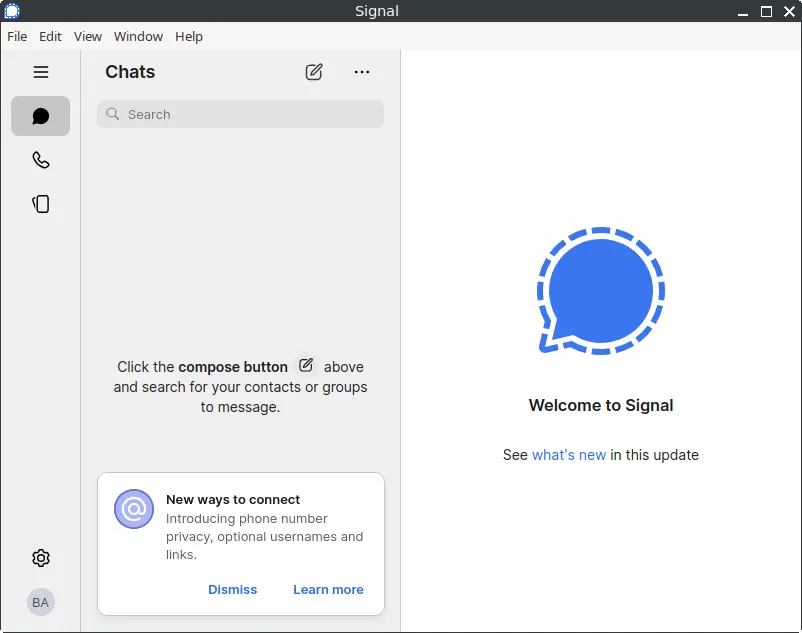Signal Desktop is one of the most secure messaging applications available today. It allows you to send encrypted messages, make voice and video calls, and share media safely with friends and colleagues. FunOS users can easily install Signal Desktop through the Terminal by adding the official Signal repository.
This guide will show you step by step how to install Signal Desktop on FunOS, how to launch it, and how to completely remove it if you ever need to uninstall it.
What is Signal?
Signal is an open-source, cross-platform messaging application focused on privacy and security. It provides end-to-end encryption for all messages and calls, ensuring that no one— not even Signal itself—can read your communications. Signal is available on Android, iOS, and desktop platforms such as Linux, Windows, and macOS.
Signal Desktop allows you to link your account from your mobile device, letting you send and receive messages directly from your computer. For those who value security and open-source software, Signal is one of the best messaging solutions available.

How to Install Signal Desktop on FunOS
Follow these steps carefully to install Signal Desktop on FunOS.
Step 1: Open a Terminal
You can open a Terminal using any of the following methods:
- Click Menu in the lower-left corner of the screen, then click Terminal
- Click the Terminal icon in the Tray
- Press Ctrl + Alt + T
Step 2: Update the Package List
Before installing any new software, it’s a good idea to refresh the package list to make sure you get the latest version of available packages.
sudo apt updateStep 3: Install the Necessary Dependencies
Signal requires certain dependencies to be installed first. Run this command:
sudo apt install apt-transport-https curlStep 4: Add the GPG Key
Add the official Signal signing key so your system can verify the authenticity of the packages.
curl -fsSL https://updates.signal.org/desktop/apt/keys.asc | gpg --dearmor | sudo tee /usr/share/keyrings/signal-desktop-keyring.gpg > /dev/nullStep 5: Add the Repository
Next, add the official Signal repository to your system sources list.
curl -fsSL https://updates.signal.org/static/desktop/apt/signal-desktop.sources | sudo tee /etc/apt/sources.list.d/signal-desktop.sources > /dev/nullStep 6: Update the Package List Again
After adding the repository, update the package list again so your system recognizes the new repository.
sudo apt updateStep 7: Install Signal Desktop
Now install Signal Desktop by running:
sudo apt install signal-desktopStep 8: Reload the Menu
After installation, you need to reload the menu so the new application appears.
- Click the Menu button in the lower-left corner
- Click Reload menu
Launching Signal Desktop
After reloading the menu, you can open Signal Desktop by following these steps:
- Click the Menu button in the lower-left corner
- Navigate to the Internet section
- Click Signal
The first time you launch Signal Desktop, it will prompt you to link it with your mobile Signal app. Simply scan the QR code displayed on your screen using your mobile device to connect.
How to Uninstall Signal Desktop on FunOS
If you ever want to remove Signal Desktop from your system, follow the steps below.
Step 1: Open a Terminal
You can open a Terminal the same way as before.
Step 2: Remove Signal Desktop
Run the following command to remove Signal Desktop completely:
sudo apt remove --purge signal-desktopStep 3: Remove Any Unused Dependencies
To clean up unnecessary dependencies that were installed automatically, run:
sudo apt autoremove --purgeStep 4: Remove the Repository and Key (Optional)
If you don’t plan to reinstall Signal Desktop in the future, you can remove its repository and GPG key.
sudo rm -f /etc/apt/sources.list.d/signal-desktop.sources
sudo rm -f /usr/share/keyrings/signal-desktop-keyring.gpgStep 5: Update the Package List
Refresh your system’s package list again to ensure everything is clean and up to date.
sudo apt updateStep 6: Remove User Data (Optional)
If you also want to delete your Signal configuration and chat history, remove the Signal configuration directory:
rm -rf $HOME/.config/Signal⚠️ Note: This step will permanently delete your Signal Desktop chat history.
Step 7: Reload the Menu
Finally, reload the menu again to remove the Signal Desktop entry.
- Click the Menu button in the lower-left corner
- Click Reload menu
Conclusion
Installing Signal Desktop on FunOS is straightforward and secure thanks to the official repository provided by Signal. With Signal Desktop, you can conveniently send and receive encrypted messages directly from your computer while keeping your privacy intact.
Whether you’re using Signal for personal chats or professional communication, it’s an excellent open-source choice for those who value privacy and data security.

Leave a Reply